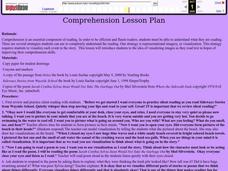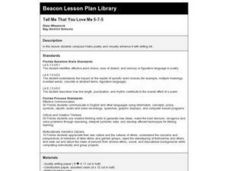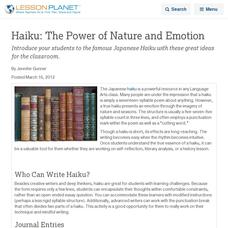Alabama Learning Exchange
J. Alfred Hyperbolizes
Mermaids will sing to your class members as they engage in an activity related to T.S. Eliot's famous dramatic interior monologue. After engaging in a socratic seminar about literary devices in the poem, individuals choose one...
National Endowment for the Humanities
Jacob Lawrence's Migration Series: Removing the Mask
Describe, analyze, compare and contrast poets from the Harlem Renaissance. Critical thinkers analyze the imagery, characterization, tone, symbolism, and historical context of Jacob Lawrence, Helene Johnson, and Paul Laurence Dunbar. A...
Curated OER
Picturing Shakespeare: Creating Illuminated Texts
Students experiment with illuminating important text. For this fictional literature lesson, students research Shakespearean sonnets. Students identify key elements of the sonnets, and examine the relationship between illuminated text...
Curated OER
The Art of Romare Bearden
Young scholars examine the works of artist Romare Bearden. In an online activity, they scrutinize his work, "Tomorrow I May Be Far Away." by moving the mouse over it. Students also compose poems inspired by one of Bearden's works.
Curated OER
Picture This!
Learners practice visualizing images as they read text to help improve their comprehension skills. The teacher models a visualizing technique, and the passes out two poems for the students to read silently. The class creates a Venn...
Curated OER
Lesson Three: Go Free or Die
Fourth graders look for sensory details and figurative language. For this reading strategy lesson, 4th graders read the story Go Free or Die by J. Ferris and complete a chart with figurative language. They use a word wall in the class to...
Curated OER
Read It, See It!
Students review the concept of silent reading and discuss the meaning of visualization. They listen to a poem as it is read and close their eyes to try to make a picture of what is happening and think about the qualities the wind...
Curated OER
Comprehension
Students identify that comprehension is an essential component or reading and in order to be efficient and fluent readers. They interpret what they have read through various strategies. Finally, students use one of the strategies,...
Curated OER
Tell Me That You Love Me 5-7-5
Students listen to several examples of Haiku poetry and discuss the strict format. Then students create and edit their own Haiku poems and enhance them with ink designs.
Curated OER
Haiku: The Power of Nature and Emotion
Introduce your students to the famous Japanese Haiku with these great ideas for the classroom.
Curated OER
Use of the Simile
Fourth graders identify and write their own similes. In this literary devices lesson, 4th graders define and identify similes. The teacher scaffolds the lesson so that all students can write their own similes.
Curated OER
The Death of the Ball Turret Gunner
Students read and analyze a poem about a speaker's posthumous view of war, assess the purpose of an author's note and evaluate the effect of the point of view on the reader's response. They work in groups to discuss and analyze the poem.
Curated OER
Getting To Know You
Students prepare for and respond to literature selections. This package includes ten lessons from the American Literature series, each covering a different reading selection. Pre-reading and response activities are included for each...
Curated OER
Comparing Characters Across Two Short Stories
Ninth graders listen to a read aloud of two short stories focusing on literary devices. The write about the settings and realism of the stories, and decide each main character handles the conflict he faces with nature.















